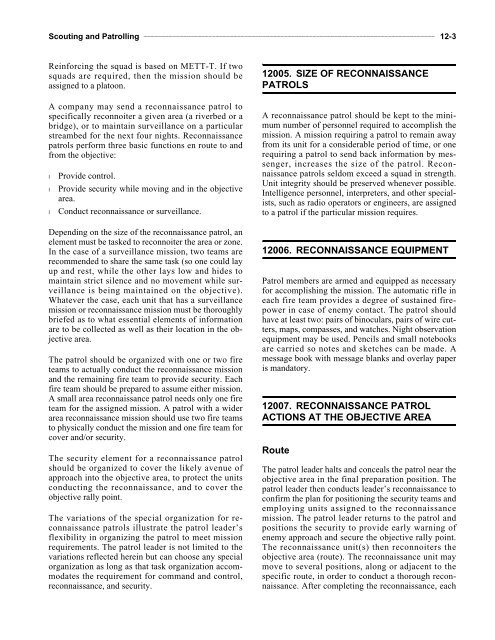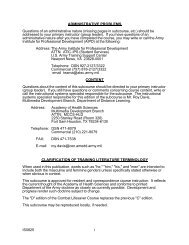MCWP-3-11.3-Scouting-and-Patrolling
MCWP-3-11.3-Scouting-and-Patrolling
MCWP-3-11.3-Scouting-and-Patrolling
Create successful ePaper yourself
Turn your PDF publications into a flip-book with our unique Google optimized e-Paper software.
<strong>Scouting</strong> <strong>and</strong> <strong>Patrolling</strong> _________________________________________________________________________________ 12-3Reinforcing the squad is based on METT-T. If twosquads are required, then the mission should beassigned to a platoon.A company may send a reconnaissance patrol tospecifically reconnoiter a given area (a riverbed or abridge), or to maintain surveillance on a particularstreambed for the next four nights. Reconnaissancepatrols perform three basic functions en route to <strong>and</strong>from the objective:l Provide control.l Provide security while moving <strong>and</strong> in the objectivearea.l Conduct reconnaissance or surveillance.Depending on the size of the reconnaissance patrol, anelement must be tasked to reconnoiter the area or zone.In the case of a surveillance mission, two teams arerecommended to share the same task (so one could layup <strong>and</strong> rest, while the other lays low <strong>and</strong> hides tomaintain strict silence <strong>and</strong> no movement while surveillanceis being maintained on the objective).Whatever the case, each unit that has a surveillancemission or reconnaissance mission must be thoroughlybriefed as to what essential elements of informationare to be collected as well as their location in the objectivearea.The patrol should be organized with one or two fireteams to actually conduct the reconnaissance mission<strong>and</strong> the remaining fire team to provide security. Eachfire team should be prepared to assume either mission.A small area reconnaissance patrol needs only one fireteam for the assigned mission. A patrol with a widerarea reconnaissance mission should use two fire teamsto physically conduct the mission <strong>and</strong> one fire team forcover <strong>and</strong>/or security.The security element for a reconnaissance patrolshould be organized to cover the likely avenue ofapproach into the objective area, to protect the unitsconducting the reconnaissance, <strong>and</strong> to cover theobjective rally point.The variations of the special organization for reconnaissancepatrols illustrate the patrol leader’sflexibility in organizing the patrol to meet missionrequirements. The patrol leader is not limited to thevariations reflected herein but can choose any specialorganization as long as that task organization accommodatesthe requirement for comm<strong>and</strong> <strong>and</strong> control,reconnaissance, <strong>and</strong> security.12005. SIZE OF RECONNAISSANCEPATROLSA reconnaissance patrol should be kept to the minimumnumber of personnel required to accomplish themission. A mission requiring a patrol to remain awayfrom its unit for a considerable period of time, or onerequiring a patrol to send back information by messenger,increases the size of the patrol. Reconnaissancepatrols seldom exceed a squad in strength.Unit integrity should be preserved whenever possible.Intelligence personnel, interpreters, <strong>and</strong> other specialists,such as radio operators or engineers, are assignedto a patrol if the particular mission requires.12006. RECONNAISSANCE EQUIPMENTPatrol members are armed <strong>and</strong> equipped as necessaryfor accomplishing the mission. The automatic rifle ineach fire team provides a degree of sustained firepowerin case of enemy contact. The patrol shouldhave at least two: pairs of binoculars, pairs of wire cutters,maps, compasses, <strong>and</strong> watches. Night observationequipment may be used. Pencils <strong>and</strong> small notebooksare carried so notes <strong>and</strong> sketches can be made. Amessage book with message blanks <strong>and</strong> overlay paperis m<strong>and</strong>atory.12007. RECONNAISSANCE PATROLACTIONS AT THE OBJECTIVE AREARouteThe patrol leader halts <strong>and</strong> conceals the patrol near theobjective area in the final preparation position. Thepatrol leader then conducts leader’s reconnaissance toconfirm the plan for positioning the security teams <strong>and</strong>employing units assigned to the reconnaissancemission. The patrol leader returns to the patrol <strong>and</strong>positions the security to provide early warning ofenemy approach <strong>and</strong> secure the objective rally point.The reconnaissance unit(s) then reconnoiters theobjective area (route). The reconnaissance unit maymove to several positions, along or adjacent to thespecific route, in order to conduct a thorough reconnaissance.After completing the reconnaissance, each



